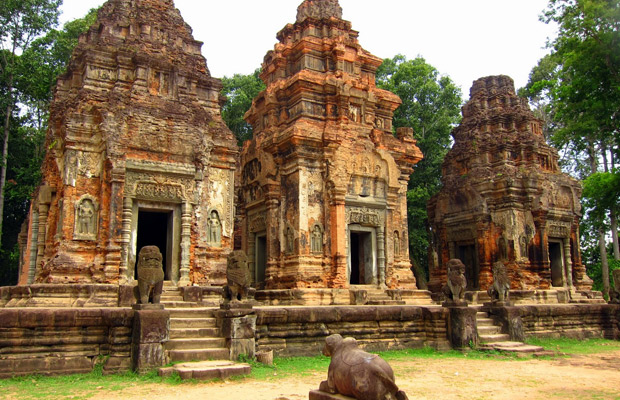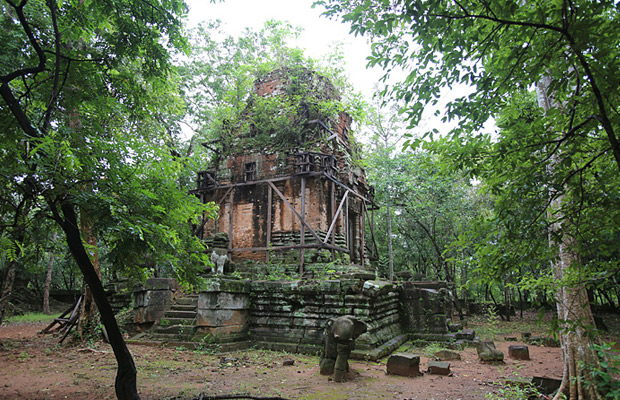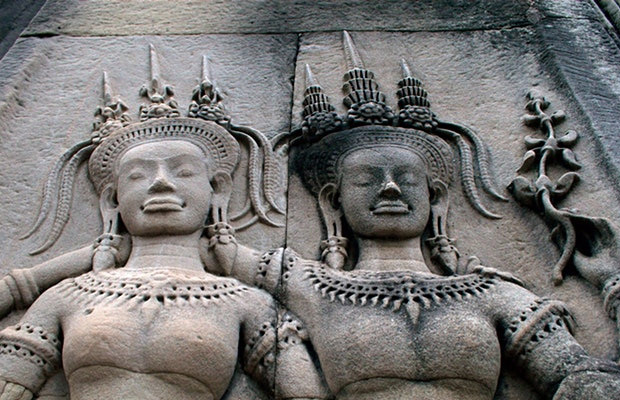Phnom Kulen
The Phnom Kulen mountain range is located 30 km north of Angkor Wat. Its name means "mountain of lychees". [3] There is a sacred site at the top of the hill. Phnom Kulen is considered a sacred mountain in Cambodia, of special religious significance for Hindus and Buddhists who come to the mountain on pilgrimage.
The Phnom Kulen mountain range is located 30 km north of Angkor Wat. Its name means "mountain of lychees". [3] There is a sacred site at the top of the hill. Phnom Kulen is considered a sacred mountain in Cambodia, of special religious significance for Hindus and Buddhists who come to the mountain on pilgrimage.
It also has an important symbolic importance for Cambodians as the birthplace of the ancient Khmer Empire, for it was in Phnom Kulen that King Jayavarma II proclaimed independence from Java in 804 CE. Jayavarman II initiated the cult of Devaraja to the king, [4]: 99-101 a cult linga, in what is dated 804 CE and declaring his independence from Java, of whom the Khmer had been a state of vassalage (if this is really "Java", the Khmer chvea used to describe Champa, or "Lava" (a lao kingdom) is debated, as well as the legend that it was previously held as a ransom of the kingdom in Java. See Angkor Civilization of Higham for more information on the debate). [5] During the Angkoran era, the relief was known as Mahendraparvata (the mountain of the Great Indra).
Kbal Spean is known for its sculptures representing fertility and its waters, which have a special meaning for Hindus. Just 5 cm below the surface of the water, more than 1000 small sculptures of linga are engraved in the bed of the sandstone river. The waters are considered sacred, since Jayavarman II chose to bathe in the river, and the river diverted so that the bed of stone could be carved. The sculptures include a stone representation of the Hindu god Vishnu lying on the serpent Ananta, with his wife Lakshmi at his feet. [7] A lotus flower protrudes from its navel with the god Brahma. The river then ends with a waterfall and a swimming pool.
Near these mountains is Preah Ang Thom, a sixteenth-century Buddhist monastery noted for the giant reclining Buddha, the largest in the country.
The Samré tribe was once living on the edge of Phnom Kulen, extracting sandstone and transporting it to the royal sites.
The Khmer Rouge used the location as a final fortress when its regime came to an end in 1979.
View Mores Temple Guide

Krol Ko
Krol Ko in Angkor, Cambodia, is a Buddhist temple built in the late 12th century under the rule of Jayavarman VII. It is north of Neak Pean. Krol Ko is a small temple located north of Neak Pean. It ...

Preah Ko Temple
Preah Ko (Khmer: The Sagred Bull) was the first temple to be built in the ancient and now extinct city of Hariharalaya (in the area now called Roluos), about 15 kilometers southeast of the main Group ...

Banteay Kdei Temple
Banteay Kdei (Khmer: ប្រាសាទបន្ទាយ ក្តី Prasat Banteay Kdei), meaning "The Citadel of Chambers," [1] also known as "Citadel of Monks" cells, [2] is a Buddhist temple ...

Ta Keo
Ta Keo had to be the state temple of Jayavarman V, son of Rajendravarman, who had built the Pre Rup. Like Pre Rup, it has five sanctuary towers arranged in a quincunx, built at the highest level of ...

Beng Mealea
Beng Mealea or Bung Mealea (Khmer: ប្រាសាទបឹងមាលា, the name means "lotus pond" [1]) is a temple in the Angkor Wat period [2]: 118-119 located 40 km east of the main group ...

Bakong Temple
Bakong (Khmer: ប្រាសាទបាគង) is the first mountain of the sandstone temple built by the rulers of the Khmer empire in Angkor, near modern Siem Reap in Cambodia. In the last ...

Preah Vihear Temple
Preah Vihear Temple (Khmer: ប្រាសាទព្រះវិហារ Prasat Preah Vihea) is an ancient Hindu temple built during the period of the Khmer Empire, which sits atop a 525-meter ...

Baksei Chamkrong
Baksei Chamkrong is a small Hindu temple situated in the Angkor complex (Siem Reap, Cambodia). He is dedicated to Lord Shiva and used to keep a golden image of him. The temple can be seen on the left ...

Banteay Kdei Temple
Extensive monastic complex, largely unrefurbished, in the same style as Ta Prohm. It was originally built on the site of an earlier temple, and functioned as a Buddhist monastery under Jayavarman ...

Prasat Prei
Small temple ruins unite in a forest setting near Neak Pean. Remains of a gopura, the central tower and halls, and the vestiges of a library and surrounding wall. Some apsara and lintel sculptures. A ...

Prasat Bei
Prasat Bei (Khmer: ប្រាសាទបី) means "three temples", is a temple with three brick towers in a north-south row, facing east and standing on a laterite platform. The central tower ...

Prasat Sras Damrei
Prasat Damrei is named for the elephants guarding the four corners of the shrine ('damri' is Khmer for 'elephant'). The temple was built in honor of Shiva, which was worshiped here as a linga mounted ...












